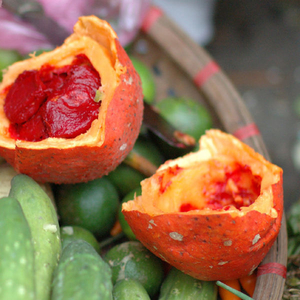
Pinyin: Mu Bie Zi Latin: Mormordica Charantia
Physical Characteristics
Momordica Charantia Spreng., commonly known as gac (IPA: /?gæk/, from Vietnamese: muop dang, or qu? g?c [qu? meaning "fruit"]; in Chinese: ???), is a Southeast Asian fruit found throughout the region from Southern China to Northeastern Australia. It is also known as Bitter Melon Baby Jackfruit, Spiny Bitter Gourd, Sweet Gourd, or Cochinchin Gourd. It has been traditionally used as both food and medicine in the regions in which it grows. Interior of ripe gac fruits Interior of ripe gac fruits Because it has a relatively short harvest season (which peaks in December and January), making it less abundant than other foods, gac is typically served at ceremonial or festive occasions in Vietnam, such as T?t (the Vietnamese new year) and weddings. It is most commonly prepared as a dish called xôi g?c, in which the aril and seeds of the fruit are cooked in glutinous rice, imparting both their color and flavor. More recently, the fruit has begun to be marketed outside of Asia in the form of juice dietary supplements because of its allegedly high phytonutrient content. Gac grows on dioecious vines and is usually collected from fence climbers or from wild plants. The vines can be commonly seen growing on lattices at the entrances to rural homes or in gardens. It only fruits once a year, and is found seasonally in local markets. The fruit itself becomes a dark orange color upon ripening, and is typically round or oblong, maturing to a size of about 13 cm in length and 10 cm in diameter. Its exterior skin is covered in small spines while its dark red interior consists of clusters of fleshy pulp and seeds.*
Family
Traditional Chinese Medicinal (TCM) Uses*
Other than the use of its fruit and leaves for special Vietnamese culinary dishes, gac is also used for its medicinal and nutritional properties. In Vietnam, the seed membranes are used to aid in the relief of dry eyes, as well as to promote healthy vision. Similarly, in Traditional Chinese medicine the seeds of gac, known as mubiezi (Chinese: ???), are employed for a variety of internal and external purposes. Recent attention is also beginning to be attracted in the West because of chemical analysis of the fruit suggesting that it has high concentrations of several important phytonutrients. Gac has been shown to be especially high in lycopene content. Relative to mass, it contains up to 70 times the amount of lycopene found in tomatoes. It has also been found to contain up to 10 times the amount of beta-carotene of carrots or sweet potatoes. Additionally, the carotenoids present in gac are bound to long-chain fatty acids, resulting in what is claimed to be a more bioavailable form. There has also been recent research that suggests that gac contains a protein that may inhibit the proliferation of cancer cells.*
References
Sources: Momordica Cochinchinensis Gac Fruit
Natural dietary supplements are designed to offer the body support to promote health, harmony, balance and overall well being.*

 Get Well Natural, LLC
Get Well Natural, LLC  Kidney Function & Regeneration Health
Kidney Function & Regeneration Health  Platelet & Blood Cell Health
Platelet & Blood Cell Health  Prostate, Flow & Function Health
Prostate, Flow & Function Health  General Mind & Body Health
General Mind & Body Health  Heart, Cholesterol & Cardio Health
Heart, Cholesterol & Cardio Health  Allergy-Free Body
Allergy-Free Body  Anxiety & Stress
Anxiety & Stress  Blood Platelet Counts & Function
Blood Platelet Counts & Function  Blood Pressure Health
Blood Pressure Health  Kidney Health
Kidney Health  Immune System Health & Balance
Immune System Health & Balance  Prostate & Urinary Health Function
Prostate & Urinary Health Function  Blood Sugar Balance
Blood Sugar Balance  Cardiovascular Heart Health
Cardiovascular Heart Health  Detoxification & Healthy Cells
Detoxification & Healthy Cells  Women's Health
Women's Health  Liver Regeneration
Liver Regeneration  Pain-Free Body
Pain-Free Body  Water & Air Filtration
Water & Air Filtration 


